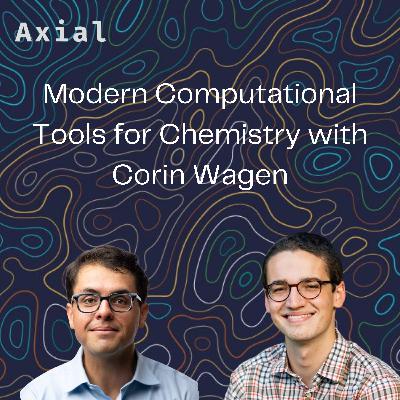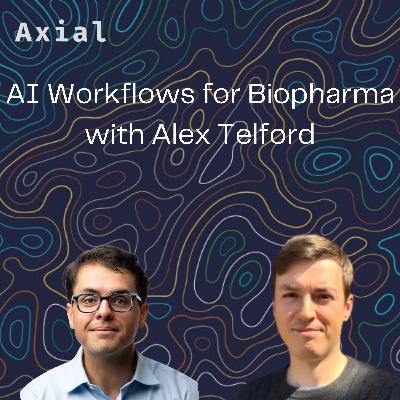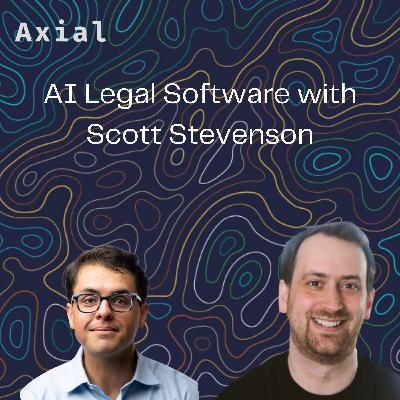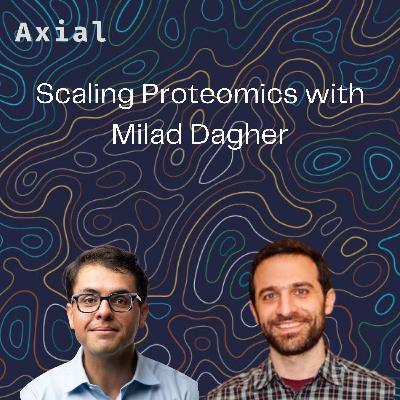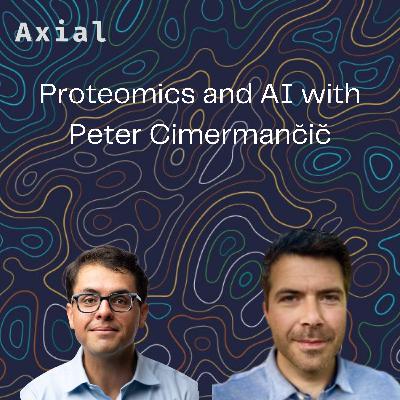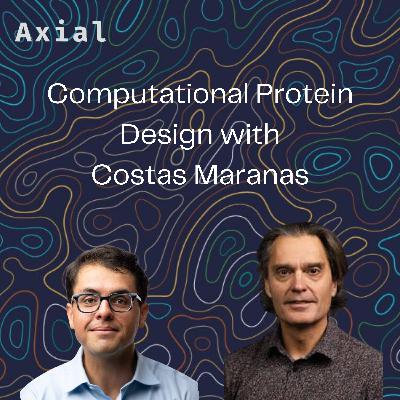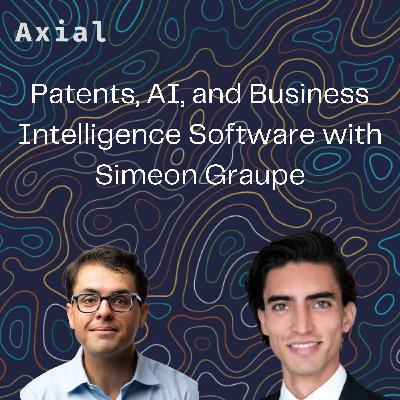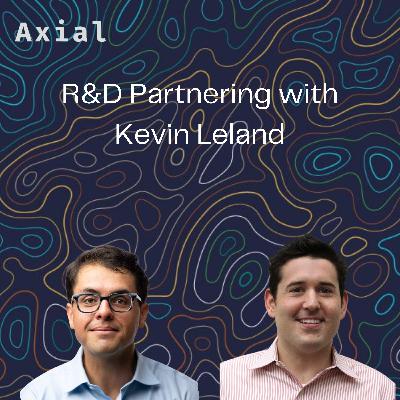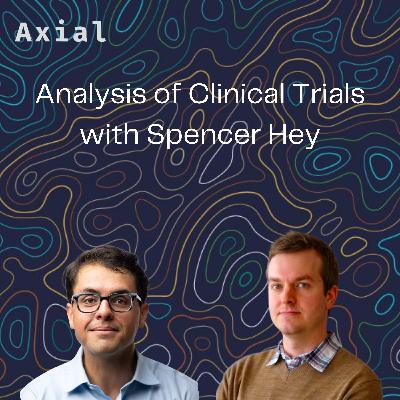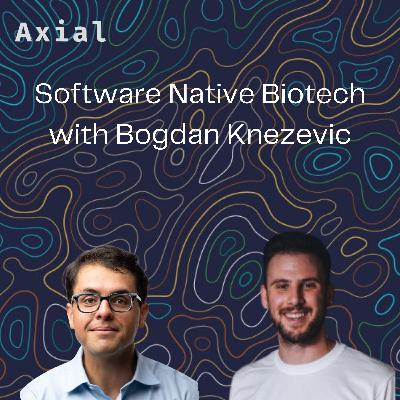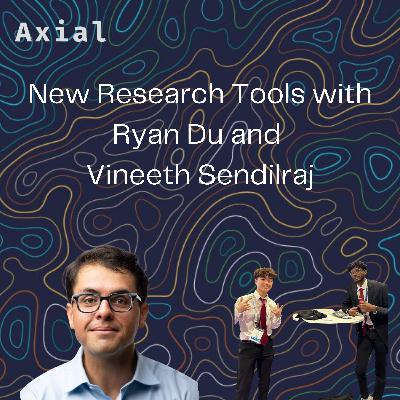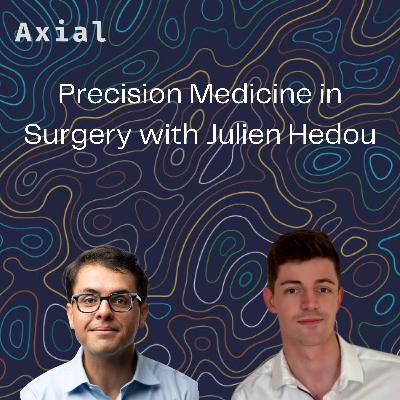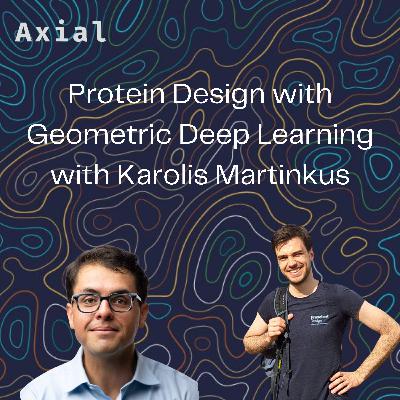Discover Axial Podcast
Axial Podcast

Axial Podcast
Author: Joshua Elkington
Subscribed: 10Played: 55Subscribe
Share
© Joshua Elkington
Description
Conversations with great founders and inventors in life sciences.
Axial partners with great founders and inventors. We invest in early-stage life sciences companies such as Appia Bio and Seranova Bio often when they are no more than an idea. If you or someone you know has a great idea or company in life sciences, Axial would be excited to get to know you and possibly invest in your vision and company. We are excited to be in business with you - email us at info@axialvc.com
Read our newsletter: https://axial.substack.com/
Axial partners with great founders and inventors. We invest in early-stage life sciences companies such as Appia Bio and Seranova Bio often when they are no more than an idea. If you or someone you know has a great idea or company in life sciences, Axial would be excited to get to know you and possibly invest in your vision and company. We are excited to be in business with you - email us at info@axialvc.com
Read our newsletter: https://axial.substack.com/
53 Episodes
Reverse
Corin Wagen is the Founder and CEO of Rowan. During our conversation, we talk about Corin's journey from the Jacobsen Lab at Harvard to starting Rowan with his brother. Rowan builds design and simulation software for chemistry. The company uses machine learning on quantum mechanics data to predict molecular interactions with high accuracy. Rowan trains its models on internal data and information from publicly available datasets. The key part of the product is reducing the time to make these predictions. Legacy, often on-prem, software can take weeks of computing to calculate, say the pKa or redox potential of a compound. Rowan uses machine learning to speed up these predictions with comparable accuracy.Rowan’s vision is to make their tools accessible to all types of chemists and scientists, not just experts in particular areas of computational chemistry. Making computational chemistry as easy to use as Uber, Venmo, or ChatGPT. Simplifying complex calculations like reaction prediction, property estimation, and data analysis. With 100s of chemists using Rowan.
Jeremy Agresti is the Founder and CTO of Triplebar Bio.
Alex Telford is the Co-Founder and CEO of Convoke.
Scott Stevenson is the Co-Founder and CEO of Spellbook.
Milad Dagher is the Co-Founder and CEO of Nomic Bio.
Peter Cimermančič is the Co-Founder and CEO of Tesorai.
Costas Maranas is a Professor of Chemical Engineering at Penn State.
Simeon Graupe is the Co-Founder and CEO of PatentPlus.
Kevin Leland is the Founder and CEO of Halo Science.
Spencer Hey is the Co-Founder and Chief Scientific Officer of Prism Analytic Technologies.
Ronan McGovern is the Founder of Trelis.
Bogdan Knezevic is the Co-Founder and CEO of Kaleidoscope Bio.
Ryan Du and Vineeth Sendilraj are the founders of Yuno.
Julien Hedou is the Co-Founder and CEO of Surge.
Karolis Martinkus is a senior scientist at Prescient Design, the machine learning arm of Genentech.
Doug Chapnick is the Co-Founder and CEO of BioLoomics. A platform company using directed evolution to discover antibody therapeutics. Combining cell line engineering, machine learning, and imaging.
At the core of BioLoomics' technology is directed evolution, a process that mimics natural evolution in the lab. The company uses this to create biologics for a given property like target engagement or stability. Traditional directed evolution relies on displaying proteins on the surface of cells or viruses and using binding or activity assays to isolate variants with enhanced characteristics. However, this approach has limitations, especially when evolving complex proteins like antibodies that require proper folding and post-translational modifications found in human cells.
BioLoomics circumvents these issues by using human cell libraries that naturally produce fully human antibodies. Their key innovation is an advanced imaging and computer vision system that can track millions of individual cells in these libraries and quantify cellular phenotypes using fluorescent biosensors. This allows them to precisely identify rare cells producing antibodies with the desired activity.
For example, BioLoomics might engineer biosensor cell lines where a fluorescent protein reports on the degradation of a specific target protein. They can then screen human antibody libraries in these cells, using computer vision to pick out the few cells that show enhanced degradation of the target compared to typical antibodies. By isolating the genetic sequences encoding these rare antibodies, they can rapidly iterate and evolve highly specific protein degraders or other therapeutic antibodies.
This live cell-based directed evolution approach has several key advantages. First, by working in human cells, BioLoomics ensures their engineered antibodies are naturally folded, glycosylated, and trafficked properly for optimal therapeutic activity. Second, the use of biosensors allows them to select for very specific mechanisms of action, rather than just binding - enabling development of precisely targeted degraders or modulators. Finally, the high-throughput nature of their platform facilitates rapid exploration of vast protein sequence landscapes to find optimal solutions.
In our conversation, we also talk about Doug’s work that set up BioLoomics. His PhD work at the University of Colorado Boulder focused on understanding cellular signaling networks and mechanisms through multi-omics approaches like proteomics and metabolomics. After, he was part of the DARPA Rapid Threat Assessment program, where he built out high-throughput microscopy workflows. Where the core idea behind BioLoomics emerged from this DARPA project. Chapnick co-founded BioLoomics in 2019 to bring directed evolution to therapeutic antibody development.
A key focus area for BioLoomics is developing novel antibody degraders that can precisely remove target proteins from cells by marking them for lysosomal degradation. While a few companies have developed degraders based on binding to specific E3 ligase enzymes, BioLoomics' platform allows them to evolve degraders that act through diverse and unexplored mechanisms not limited to any single pathway. For example, they could evolve antibodies that traffick target proteins to lysosomes through interactions with sorting receptors or endocytic adaptor proteins. Or create antibody fusions that oligomerize targets and induce their proteasomal degradation. The diversity of potential mechanisms enabled by their platform could lead to a whole new class of highly specific protein degraders for tackling undruggable targets across multiple disease areas. By combining human cell libraries, advanced imaging, computer vision, and directed evolution, BioLoomics is pioneering a new path for antibody discovery.
Evan Zimmerman is the Co-Founder and CEO of Edge, that helps patent attorneys, patent agents, and inventors make the patent process less painful and more effective.
He earned a Juris Doctor (JD) degree from the UC Berkeley Law School, where he specialized in IP law. Seeing the potential of AI to transform the patent system, Zimmerman teamed up with Len Boyette, an early employee at Okta. Together, they went through the Y Combinator accelerator program in 2022 to build Edge.
Edge's AI-powered patent assistant aims to automate and streamline every step of the patent process, from recreating patent claims from basic technology descriptions to suggesting improvements and identifying relevant prior art. This approach removes the grunt work for attorneys and patent agents while making high-quality patents more accessible for inventors and companies.
The patent system is critical for protecting inventions and stimulating innovation, but is often cumbersome for all involved. For attorneys and patent agents, the system involves painstaking hours poring over documents, extracting key technical details, and translating those details into watertight patent claims. For inventors and companies, the costs and complexities of patents can be prohibitive.
Edge aims to change all that by using AI to automate and streamline every step of the patent process. Evan describes Edge as "the ultimate patent assistant", able to recreate patent claims from basic technology descriptions, suggest areas for improvement, and more. This removes grunt work for practitioners while making high-quality patents more accessible for innovators.
Edge's product offering is centered on a patent editor and assistant app. For example, Edge generated claims mimicking those from the famous PageRank patent solely from a description of the technology, capturing nuances an inventor might have missed. Its AI also suggests ways to strengthen claims, identifies relevant prior art, and more.
Evan sees Edge as revolutionizing how patents are created and managed. For attorneys and agents, it removes the drudgery of claim drafting and prior art searching. For inventors and companies, it makes robust patents far more accessible. He sees patents as a rising tide that can lift all boats when done right. By using technology to democratize access to effective patents, Edge seeks to empower inventors.
Just as the Kitty Hawk Flyer gave rise to modern aviation, robust yet accessible patents can spur the next wave of human ingenuity.
Daniel Sabanés Bové is a senior principal data scientist at Roche. In our conversation, we discuss the need for better software in biotech and his career in data science.
Daniel studied statistics at Ludwig Maximilian University of Munich in Germany, earning his PhD in 2013 from the University of Zurich in Switzerland. His doctoral research focused on Bayesian model selection. After completing his PhD, Daniel began his at Roche as a biostatistician. There, he applied statistical principles to clinical trials and research in areas like oncology, immunology, and neuroscience.
In 2018, Daniel joined Google as a data scientist. While there, he worked on ranking systems, developing models to optimize search results. Then in 2020, Daniel returned back to Roche to lead a specialized team focused on statistical engineering.
Throughout his career, Daniel has co-authored multiple R packages published on CRAN and Bioconductor. He also co-wrote the book 'Likelihood and Bayesian Inference: With Applications in Biology and Medicine'. Currently, he serves as co-chair of an ASA working group called openstatsware that promotes software engineering in biostatistics.
According to Daniel, software engineering principles are often neglected in biostatistics. Most biostatisticians know a programming language like R, but lack formal training in writing reusable, reliable code. Daniel argues this is problematic for several reasons.
First, without code reviews, we risk making erroneous analytical decisions based on buggy statistical software. Code passed from statistician to statistician without documentation makes reproducibility impossible. In regulated fields like pharmaceuticals, validation protocols are needed to verify analyses, but require engineered code. Even modifying poorly written software can introduce unexpected behaviors without sufficient testing.
To address these problems, Daniel calls on the biostatistics community to prioritize software engineering skills. Change starts with awareness - we must recognize the value of good engineering. Next, software engineering concepts need integration across statistics curriculums - in both academia and industry.
Dedicated software engineering teams play a key role. They can catalyze adoption of engineering best practices within research teams and provide training. Providing attractive career growth for software-oriented roles aids retention of technical talent.
Cross-organizational collaboration also helps. By sharing insights and contributing to open source tools, we make better use of resources. Following modern engineering practices facilitates building reusable components. Daniel points to projects like Mediana (for clinical trial simulations) as examples of successful collaborative open source biostatistics software.
What could improved software engineering mean for biostatistical analyses? Daniel foresees greater efficiency and integrity. With robust code review protocols, analyses have higher accuracy. Well-documented software enhances reproducibility. A strong testing culture provides safety nets against inadvertent bugs. Modular, reusable code makes implementing new analyses faster. Validation frameworks give regulators necessary confidence in results.
Daniel also notes how high-quality software enables faster innovation. By encapsulating complex methods in packages, researchers can build on previous work rather than recoding from scratch. Reliable software tools empower statisticians to operate at higher levels of abstraction.
Ultimately, Daniel argues that pursing excellence in software engineering serves both ethical and practical ends. Ethically, biostatisticians have an obligation to provide sound statistical guidance. Pursuing engineering excellence helps fulfill this duty. Practically, improved software engineering makes biostatisticians more effective in their work - accelerating discoveries and powering data-driven decisions.
Excited to have a conversation with Martin Permin, Founder and CEO of Invert. The company is on a mission to transform biomanufacturing through advanced software and data analytics. We discuss the founding of Invert, what capabilities they give their customers, and the importance of biomanufacturing to grow biological products like proteins, enzymes, and specialty chemicals. Production from bioreactors allows us to produce important medicines, sustainable materials, biofuels, and other products that will shape our future. However, it's incredibly complex with so many variables to control. A perfect place for software to shine. And where Invert comes in.
Martin started the company in 2021 to help biomanufacturers manage, analyze, and optimize their data. The Invert platform integrates with bioreactors and databases to capture bioprocessing data. It then applies AI and analytics to surface insights and identify process improvements. Just ID’ing ways to improve, or avoiding bad runs, in bioprocessing is a major pain point for companies trying to develop or scale up their manufacturing. Invert makes it seamless to manage these processes across an organization.
Before starting Invert, Martin had an entrepreneurial career with roles at Airbnb and Hive. Then saw an opportunity to bring a modern software solution to the biotech industry. Invert’s features really exemplify this vision. The platform provides tools for planning experiments, monitoring bioprocess runs as they happen, analyzing results across projects, modeling scale-up, and collaborating with partners. It works to eliminate all the manual workflows that hold companies back.
Since launch, Invert has had strong traction within synthetic biology and industrial biotech setting up expansion to biopharma customers. For many, it's become mission-critical for managing their data and enabling team collaboration. In our conversation, Martin talks about how customers use Invert at various stages of their product development. From optimizing algae strains to make renewable chemicals. To developing synthetic meats and helping customers compare runs across sites. Martin also shares his vision for the future of biomanufacturing and software for biotech. Where he paints a picture on how data-driven science can lead to more accessible medicines, foods, and materials.
Errik Anderson is the CEO and Founder of Alloy Therapeutics. Founded in 2017, the company democratizes access to drug discovery platforms and services. In our conversation, we discuss Alloy's product offering and story.
Alloy has rapidly grown into a thriving ecosystem empowering the global scientific community. The company's innovative business model is centered on 3 pillars: platforms, services, and company creation. Alloy develops technologies such as its ATX-Gx humanized transgenic mice antibody discovery platform and makes them available to partners through non-exclusive, affordable licensing. This allows even academic labs and small biotechs to use powerful tools previously only accessible to large pharmas. Alloy also provides tailored drug discovery services, running campaigns for clients seeking to outsource highly specialized work. Anderson embraces the "service mentality" as it generates revenue to improve Alloy's platforms, while solving problems for partners.
The third pillar is Alloy's venture studio 82VS, which incubates startups. By providing access to platforms, services, and expertise, Alloy enables entrepreneurs to rapidly validate ideas and generate data, removing traditional barriers faced by first-time founders. Anderson views this as a way to "democratize" access not just to technology, but also capital and talent.
Fundamental to Alloy's model is a commitment to accessibility and collaboration. Anderson envisions that sharing innovations, rather than hoarding them, can accelerate the overall pace of progress. The company now has over 150 partners, including top pharmas, biotechs, and academics. Unusually, Alloy reinvests 100% of its revenues into developing new technologies and making them available to all. This mentality allows for a longer-term approach compared to the traditional biotech company.
Anderson's vision for Alloy is ambitious - to reduce barriers so the best scientific ideas can efficiently become therapies that help patients. Leading to a motto emblazoned on everything from shirts to jackets: 'Let the best drug win.'
Central to Alloy's identity is Anderson himself. Anderson thinks in unique ways, evidenced by Alloy's unique perpetual structure - its controlling stock can never be sold. This allows for indefinitely long timelines, reinforced by the policy of reinvesting all revenues.
Looking ahead, Alloy is expanding into new modalities like oligonucleotides, cell therapy and peptide discovery. Continuing to drive its democratization agenda, Alloy has potential to reshape how biotech innovation happens. With Anderson's bold vision, the company is accelerating scientific progress and drug development. By enabling startups and academic groups to access tools previously only available to big pharma. Alloy now powers drugs heading into the clinic across its network.


